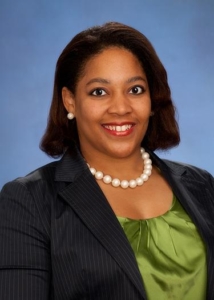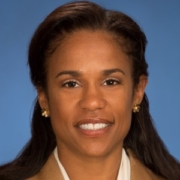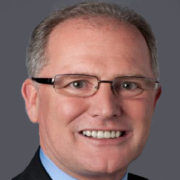Voice of Experience: Aynesh Johnson, Head of the Office of Global Leadership and Diversity, Goldman Sachs
 “Look ahead to other senior women who have gone through the experience and learn from them,” said Aynesh Johnson, Managing Director and Head of the Office of Global Leadership and Diversity at Goldman Sachs. But, she continued, “Be comfortable that you will be successful and do it on your own terms.”
“Look ahead to other senior women who have gone through the experience and learn from them,” said Aynesh Johnson, Managing Director and Head of the Office of Global Leadership and Diversity at Goldman Sachs. But, she continued, “Be comfortable that you will be successful and do it on your own terms.”
Johnson, who has been with Goldman since the beginning of her career, is enthusiastic about the importance of leveraging mentors and sponsors throughout one’s career. But, she said, ultimately you are responsible for your own success.
“You have to be able to find support, but you are responsible for owning your career,” she advised.
From Investment Banking to Human Capital Management
Johnson studied math at Duke, and came to Wall Street for a summer internship, doing equity research in the field of defense and aerospace.
“In 1992, I accepted a first year analyst position at Goldman Sachs, and spent three years in investment banking, doing corporate finance for companies out of the Midwest, like Sara Lee and Maytag.” She recalled, “I chose investment banking, because I knew I enjoyed the thrill of quantitative reasoning and the ability to analyze, but I wanted an opportunity to merge my technical interests with my communications and marketing skills while still having the opportunity to engage with a broad client base.”
Johnson decided to go back to school, and got her MBA at Harvard Business School. Then she returned to Goldman in 1997, and spent another six years in corporate finance and mergers and acquisitions, serving as a strategic advisor.
In addition to her client facing work, Johnson began working on internal firm projects, becoming a “GS culture carrier.” She teamed up with the affinity networks, training and development team, and the firm’s internal recruiters to assist in creating greater opportunities for the firm’s diverse population. “Then, in late 2003, I was asked to consider joining the team that was helping to develop diversity efforts at the firm,” she said. Johnson accepted the offer – and is now Goldman’s global head of diversity and inclusion.
Professionally, Johnson said her proudest achievement so far was being promoted to managing director in 2009. “The notion of having a long tenured career and having the opportunity to work in multiple areas of the firm is rewarding,” she explained.
Leading Global Diversity Efforts within Goldman
“The majority of my efforts pertain to responding to the firm’s goals of attracting, retaining, and promoting diverse talent,” said Johnson.
“I still have clients,” she explained. “I still analyze data and deliver strategy. But now my clients are internal. And internal clients’ needs are just as important as the firm’s external clients,” she said.
With the people of Goldman Sachs being one of the most important assets of the firm, Johnson’s team serve as thought leaders for taking the firm’s diversity and inclusion efforts to the next level. “We’re very focused on our brand and our reputation,” she said. “We want to be viewed as a compelling place for top talent to come to work.”
“There’s a war for talent – we need to be able to bring the best and brightest to the forefront to provide the right solutions for our clients.”
Looking to the future, she said, “Hopefully I’ll still be here at Goldman Sachs, focusing on human capital management and working with our senior leaders in building out our global business franchise.”
She explained, “Where is the next level of growth in terms of GDP? China, India, and Brazil. How we manage diversity globally is a corporate imperative – how to make sure we are managing diversity in a way that ensures we are successful in the growth markets [is a key area of focus].”
“This is an exciting and energetic time to be in the diversity and inclusion space,” she continued. “The talent overlay is global.”
She continued, “As we expand our global footprint, we need to act locally. We have a global team with individual regional leadership. How we define diversity morphs as we move around the globe.”
Johnson mentioned some of the firm’s diversity and inclusion initiatives, including 10,000 Women and 10,000 Small Businesses, which have the goal of improving the business acumen of small business owners across the US and in developing markets, and providing job creation.
Advice for Women on Wall Street
“I’m from Atlanta,” Johnson began. “And New York is a unique and different place. In my class, I was the only African American analyst. I asked myself, ‘did I make the right choice?’”
She continued, “I chose Goldman Sachs because I had been told to go to a firm where individuals are valued regardless of background. It’s a firm that will help support you in your career.”
Regarding lessons learned, Johnson said, “I wish I had better understood the power of networking. A broader group of relationships helps you make sure you have the right avenues for information and feedback. It’s about information flow and working smart versus only working hard,” she explained. “I would have been much more thoughtful about my strategic network, both with my peers and with individuals who were senior to me.”
Goldman Sachs has a number of programs in place to help women create those networks, she said, including 35 women’s networks across the globe, designed to respond to unique cultural needs. Johnson also mentioned the firm’s interbank Brokering Change conference for multicultural women in financial services. “The purpose is to build networks across companies and connect women with mentors and sponsors, as well as to improve individuals’ insight into markets from a commerciality perspective.”
Another program that Johnson and her team developed is the Women’s Career Strategies Initiative (WCSI). “It’s a global six-month development program for women making the transition from associate to vice president, a time when their roles should shift from ‘do-er’s’ to strategic leaders. The program provides training in leadership, broadens participants’ exposure to the firm’s businesses and culture, and facilitates access to senior leaders and role models.”
The work/life issue is another challenge, Johnson said. “Work/life balance sounds like a trade-off. I prefer to say work/life integration. We have different priorities at different times of our lives. Everyone has to build the right equation or solution for themselves.”
But, she said, the firm works hard to ensure that individuals can make those choices. “You have the opportunity to make different choices and still be successful.” In addition to flexwork options, telecommuting, and back-up child-care services, the firm also initiated the “Returnship” program, which is a ten-week internship for women who have been out of the workforce for over 2 years. “They have the potential to find full time opportunities if they are the right fit,” she said. The program was launched first in Goldman’s New York headquarters, but it is now global with programs in Hong Kong, Singapore and Salt Lake City.
In Her Spare Time
Outside the office, Johnson enjoys adventure travel. Having recently returned from a bicycle trip to Vietnam and Cambodia, she has also biked in Morocco, trekked in the Himalayas, and sailed in Croatia. “It’s a way of extending my horizons in a way that is a little off the beaten path,” she said.
She also serves as the president of the Lincoln Square Neighborhood Center, a non-profit providing social services to underprivileged families near Lincoln Center in New York. “It’s very rewarding,” she said. “It’s an opportunity to give back in the community where I live.”
By Melissa J. Anderson (New York City)










I concur with everything Ms. Johnson said about women in the workplace and am always encouraged when there’s enlightened leadership around this issue. I’m particularly in sync on the notion that mentoring/sponsoring is only part of the equation and that ultimately, women must take ownership of their own careers. And, while corporate initiatives around flextime, telecommuting, emergency child care, etc. were necessary (for everyone), they’re far from sufficient. To both stem the female brain drain and enable more women to get to the top, women’s thinking must change so they can withstand the slings and arrows that come at them in the more male-dominated industries. Real, sustained change is an inside out process and begins with the individual.
All of this said, it saddens me that the success of women in the workplace still qualifies as a diversity initiative.